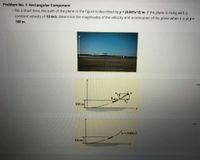
Structural Analysis
6th Edition
ISBN: 9781337630931
Author: KASSIMALI, Aslam.
Publisher: Cengage,
expand_more
expand_more
format_list_bulleted
Question

Transcribed Image Text:Problem No. 1: Rectangular Component
• For a short time, the path of the plane in the figure is described by y = (0.001x^2) m. If the plane is rising with a
constant velocity of 10 m/s, determine the magnitudes of the velocity and acceleration of the plane when it is at y =
100 m.
...
100 m
...
y 0.001x2
100 m
Expert Solution
This question has been solved!
Explore an expertly crafted, step-by-step solution for a thorough understanding of key concepts.
This is a popular solution
Trending nowThis is a popular solution!
Step by stepSolved in 3 steps

Knowledge Booster
Learn more about
Need a deep-dive on the concept behind this application? Look no further. Learn more about this topic, civil-engineering and related others by exploring similar questions and additional content below.Similar questions
- The tank of liquid in the figure accelerates to the right with the fluid in rigid body motion. Assume x = 44.1 cm and y = 106.5 cm Compute ax in m/s^2arrow_forwardThe blade on the horizontal-axis windmill shown in (Figure 1) is turning with an angular velocity of wo = 2 rad/s. It is given an angular acceleration of ac = 0.4 rad/s². Figure 15 ft 1 of 1 > Part A Determine the angular velocity of point P on the tip of the blade when t = 4 s. Express your answer in radians per second to three significant figures. wp= 2.68 195| ΑΣΦ. 41 Submit Previous Answers Request Answer Part B vec X Incorrect; Try Again; 4 attempts remaining ap = 2 ? Determine the magnitude of acceleration of point P on the tip of the blade when t = 4 s. Express your answer in feet per square second to three significant figures. IVE ΑΣΦ ↓↑ vec …..... www rad/s ? ft/s²arrow_forwardThe angular velocity of a rotating disk is defined by ω = (4t^2 + 9t + 3) rad/s, where t is in seconds. If the disk has a radius of 0.8 m: determine the magnitude of the velocity and acceleration of the disk when t=1.0 second.arrow_forward
- A particle moves along a straight line such that its position is defined by s= (t 2 - 6t + 5) m. Determine the average velocity of the particle when t = 6 sarrow_forwardA particle P moves along the spiral path r = (10/θ) ft, where θ is in radians. If it maintains a constantspeed of v = 10 ft/s, determine the magnitudes vr and vθ as functions of θ and evaluate each at θ = 1 rad.arrow_forwardThe particle travels along the path defined by the parabola y = 0.5x², where x and y are in ft. When t = 0, x = 0, y = 0. (Figure 1) Figure -y = 0.5x² 1 of 1 Part A If the component of velocity along the x axis is vx = (7t) ft/s, where t is in seconds, determine the particle's distance from the origin O when t = 3 s. Express your answer using three significant figures and include the appropriate units. ► View Available Hint(s) Submit Part B a = 0 Value μÁ Submit Determine the magnitude of the particle's acceleration when t = 3 s. Express your answer using three significant figures and include the appropriate units. ► View Available Hint(s) 8 Value Provide Feedback Units μà ? Units Review ? Next >arrow_forward
- The 28000-1b airplane is flying in the vertical plane at 390 ft/s. At the instant shown, the angle = 30°, and the cartesian components of the plane's acceleration are a = -5 ft/s², ay = 25 ft/s². Figure < 1 of 1 Part A What are the tangential and normal components of the total force acting on the airplane (including its weight)? Enter your answers numerically separated by a comma. Ft, Fn = Submit Part B * Incorrect; Try Again; 4 attempts remaining ■AΣ vec de/dt = Previous Answers Request Answer What is de/dt in degrees per second? (Figure 1) Submit VAZ † vec Request Answer ? ? lb °/sarrow_forwardPROBLEM NO. 4 A particle travels along a path described by the parabola, y = 0.5x². The x-component of velocity is given by, vx = (7t)ft/s. When t = 0,x=y= 0. Find the particle's distance from the origin and the magnitude of its acceleration when, t = 1s.arrow_forwardThe tank of water in the figure accelerates uniformly by freely rolling down a 30-degree incline. If the wheels are frictionless, what is the angle theta, Θ?arrow_forward
arrow_back_ios
arrow_forward_ios
Recommended textbooks for you

 Structural Analysis (10th Edition)Civil EngineeringISBN:9780134610672Author:Russell C. HibbelerPublisher:PEARSON
Structural Analysis (10th Edition)Civil EngineeringISBN:9780134610672Author:Russell C. HibbelerPublisher:PEARSON Principles of Foundation Engineering (MindTap Cou...Civil EngineeringISBN:9781337705028Author:Braja M. Das, Nagaratnam SivakuganPublisher:Cengage Learning
Principles of Foundation Engineering (MindTap Cou...Civil EngineeringISBN:9781337705028Author:Braja M. Das, Nagaratnam SivakuganPublisher:Cengage Learning Fundamentals of Structural AnalysisCivil EngineeringISBN:9780073398006Author:Kenneth M. Leet Emeritus, Chia-Ming Uang, Joel LanningPublisher:McGraw-Hill Education
Fundamentals of Structural AnalysisCivil EngineeringISBN:9780073398006Author:Kenneth M. Leet Emeritus, Chia-Ming Uang, Joel LanningPublisher:McGraw-Hill Education
 Traffic and Highway EngineeringCivil EngineeringISBN:9781305156241Author:Garber, Nicholas J.Publisher:Cengage Learning
Traffic and Highway EngineeringCivil EngineeringISBN:9781305156241Author:Garber, Nicholas J.Publisher:Cengage Learning


Structural Analysis (10th Edition)
Civil Engineering
ISBN:9780134610672
Author:Russell C. Hibbeler
Publisher:PEARSON

Principles of Foundation Engineering (MindTap Cou...
Civil Engineering
ISBN:9781337705028
Author:Braja M. Das, Nagaratnam Sivakugan
Publisher:Cengage Learning

Fundamentals of Structural Analysis
Civil Engineering
ISBN:9780073398006
Author:Kenneth M. Leet Emeritus, Chia-Ming Uang, Joel Lanning
Publisher:McGraw-Hill Education


Traffic and Highway Engineering
Civil Engineering
ISBN:9781305156241
Author:Garber, Nicholas J.
Publisher:Cengage Learning